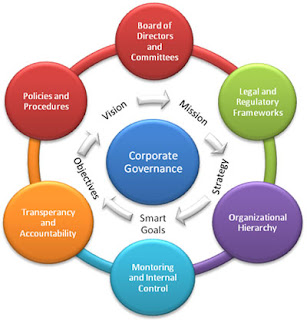Хичээл 8 Компанийн засаглал, хөрөнгө оруулагчийн эрх ашгийг хамгаалах, санхүүгийн ёс зүй
Match these corporate governance terms with definition below
incentive contracts
shareholder rights self-dealings concentrated ownership Corporate governance listing stocks expropriation induce
agency problem hostile takeover
|
When managerial 1…………….. are excessive and left unchecked, they can have serious negative effects on corporate values and the proper functions of capital markets. In fact, there is a growing consensus around the world that it is vitally important to strengthen corporate governance to protect 2……………, curb managerial excesses, and restore confidence in capital markets. 3……………………..can be defined as the economic, legal, and institutional framework in which corporate control and cash flow rights are distributed among shareholders, managers, and other stakeholders of the company.
The central issue in corporate governance is: how to best protect outside investors from 4………………. by managers and controlling insiders so that investors can receive fair returns on their funds. The 5………………..can be alleviated by various methods, including (a) strengthening the independence of boards of directors; (b) providing managers with 6………………. , such as stocks and stock options, to better align the interests of managers with those of shareholders; (c) 7……………….. so that large shareholders can control managers; (d) using debt to 8…………….. managers to disgorge free cash flows to investors; (e) 9……………………….on the London or New York stock exchange where shareholders are better protected; and (f) inviting 10………………………..bids if the managers waste funds and expropriate shareholders.
Answer to exercise
1. Self-dealings
2. shareholder rights
3. Corporate governance
4. Expropriation
5. agency problem
6. incentive contracts
7. concentrated ownership
8. induce
9. listing stocks
10. hostile takeover
Vocabulary
excessive and left unchecked – хэтэрсэн бөгөөд орхигдсон(хяналтгүй)
self-dealings – менежерүүдээс хувьцаа эзэмшигчдийн хөрөнгийг хувийн зорилгоор арилжаа хийх
curb - хязгаарлах, тогтоон барих
managerial excesses – менежерийн ёс суртахуунгүй үйлдэл
corporate governance – корпорацийн засаглал
expropriation – эд хөрөнгийг шамшигдуулах
agency problem – ашиг сонирхлын зөрчилдөөн, агентын хүндрэл
incentive contracts – сэдэлжүүлэлтийн гэрээ
concentrated ownership – төвлөрсөн эзэмшил
induce – бууруулах
listing stocks- хувьцаагаа бүртгүүлэх
hostile takeover дээрэнгүйгээр булаан авах
left unchecked –хяналтгүй орхигдох
curb managerial excesses – менежерийн хэрээс хэтэрсэн байдлыг хязгаарлах
controlling insiders – хяналт тавьж буй ажилтан
to better align – нийцүүлэх, хэтрүүлэн өгөх
listing stocks – хувьцаагаа бүртгүүлэх, хувьцаагаа арилжих
hostile takeover – түрэмгийлэн эзэмших
Listening Financial ethics
Right. Auditing for beginners. Where shall we start? Well, an audit can be compared to having an annual check-up with the doctor. Just as the patient must pass certain exams to ensure a clean bill of health, a company’s financial good health relies on whether or not its financial statements abide by generally acceptable standards and accounting principles. While the audit does not guarantee that the financial statement is perfect, it does provide a reasonable level of insurance that the statements are free of misstatements. So, in this case, the doctor is the auditor, and the company is the patient. Simple. Next, in order to judge financial statements, auditors use generally acceptable accounting principles or GAAP. Basically, financial statements are considered to conform to the GAAP if the accounting principles used by management are generally accepted throughout the profession.
Translating
Corporate governance reform efforts should be focused on how to better protect outside investors from expropriation by controlling insiders. Корпорацийн засаглалын шинэчлэл нь компанийн ажилчидаас гадны хөрөнгө оруулагчдийн хөрөнгийг хураахаас хэрхэн сайтар хамгаалах вэ гэдэгт чиглэх ёстой. Investor protection turns out to be crucial because, in many countries, expropriation of minority shareholders and creditors by the controlling shareholders is extensive. Ихэнхи улс орнуудад хувьцаа эзэмшигчдэд хяналт тогтоох замаар цөөнх хувьцаа эзэмшигчид ба зээлдэгчдийн хөрөнгийг шамшигдуулах үзэгдэл газар авч байгаа учираас хөрөнгө оруулагчийн эрх ашгийг хамгаалах нь асар их ач холбогдолтой болж байна. Poor investor protection results in concentrated ownership, excessive private benefits of control, underdeveloped capital markets, and slower economic growth. Хөрөнгө оруулагчийн эрх ашгийг хамгаалж чадахгүй нөхцөлд эзэмшлийн эрх нэг гарт төвлөрөх, эрх мэдлээ хувийн зорилгоор хэтрүүлэн ашиглах, хөрөнгө зах зээл хөгжиж чадахгүй байх, эдийн засгийн өсөлт удааширдаг.
When outside investors finance firms, they face a risk, and sometimes near certainty, that the returns on their investments will never materialize because the controlling shareholders or managers expropriate them. Хяналт тавьж буй хувьцаа эзэмшигчид буюу менежерүүд нь хөрөнгө оруулалтын өгөөжийг дангаараа хүртэснээрээ гадны хөрөнгө оруулагчдаас компанид хөрөнгө оруулахад эрсдэлтэй тулгарч тэр хирээр тодорхой бус байдал үүсдэг агаад оруулсан хөрөнгө оруулалтынхаа өгөөжийг хүртэж чаддаггүй. Expropriation can take a variety of forms. Хөрөнгө шамшигдуулах ажиллагаа нь маш олон хэлбэртэй байдаг. In some instances, the insiders simply steal the profits. Заримдаа, компанийн ажилтануудаас компанийн ашгаас хулгайлдаг. In other instances, the insiders sell the output, the assets, or the additional securities in the firm they control to another firm they own at below market prices. Зарим тохиолдолд, компанийн ажилтануудаас актив болох бүтээгдэхүүн буюу компанийн хянаж буй нэмэлт үнэт цаасыг зах зээлээс харьцангуй бага үнээр өөр компанид худалддаг.
Corporate governance is, to a large extent, a set of mechanisms through which outside investors protect themselves against expropriation by the insiders. Компанийн ажилтануудаас өмч хөрөнгийг шамшигдуулахын эсрэг гадны хөрөнгө оруулагчдийг хамгаалах механизм бол өргөн хүрээгээрээ корпорацийн засаглал юм.
Legal protection of investor rights systematically varies across countries, depending on the historical origin of the national legal system. Үндэсний эрх зүйн тогтолцооны түүхэн гарлаас хамаарч хөрөнгө оруулагчийн эрх ашгийг хуулийн үүднээс хамгаалах үйл явц нь улс орон бүрт харилцан адилгүй байдаг. English common law countries tend to provide the strongest protection, French civil law countries the weakest. Английн эрх зүйн түгээмэл тогтолцоотой орнуудад хөрөнгө оруулагчийн эрх ашгийг сайн хамгаалдаг бол Францын иргэний эрх зүйн тогтолцоотой орнуудад хөрөнгө оруулагчийн эрх ашгийг сул хамгаалдаг.
Outside the United States and the United Kingdom, large shareholders, often founding families, tend to control managers and expropriate small outside shareholders. АНУ болон Их Британиас бусад улс орнуудад томоохон хувьцаа эзэмшигчид нь үүсгэн байгуулсан гэр бүл байх бөгөөд гадны жижиг хөрөнгө оруулагчидруу халддаг. In other words, large, dominant shareholders tend to extract substantial private benefits of control. Өөрөөр хэлбэл, томоохон, давуу хувьцаа эзэмшигчид нь хяналтыг хувийн эрх ашгийн зорилгоор эзэмшдэг.
One way to think about legal protection of outside investors is that it makes the expropriation technology less efficient. Гадны хөрөнгө оруулагчдийг хууль ёсоор хамгаалах нэг арга зам нь хөрөнгө шамшигдуулах технологийг үр ашиггүй болгох явдал юм.



